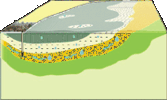| Studia Geologica Polonica |  |
Hydrogeology and Hydrogeochemistry
Edited by J. Dowgiałło
Part II
The salinity of groundwater in Mesozoic and Cenozoic aquifers of NW Poland - origin and evolution
Kaczor, D.
Studia Geologica Polonica, 126: 5-76. PDF - Full-text Article
Abstract
Dorota Kaczor
Polish Academy of Sciences, Institute of Geological Sciences, ul. Twarda 51/55, 00-818 Warszawa, Poland; dkacz@op.pl
Chemical composition of saline groundwaters occurring in the Mesozoic deposits of NW Poland, based on 285 archival chemical analyses from 113 deep boreholes, shows much similarity within particular aquifers. These are mostly chloride-sodium waters. Chloride-sodium-calcium waters predominate only within the Lower Triassic aquifer. Chloride-sodium-magnesium waters appear only at isolated locations. All the waters studied are typical of a high mineralization (TDS), the latter increases with the aquifer depth up to a maximum of 328 g/dm3 (Objezierze IG-1 well). The TDS of these brines, measured systematically over the last 40 years at production wells in the health resorts Kołobrzeg, Kamień Pomorski, Świnoujście and Połczyn Zdrój, is nearly constant and directly proportional to the concentration of Cl– ion.
The brines in Mesozoic aquifers of NW Poland are polygenetic. Their main components are fossil seawater and meteoric water. Holocene infiltration water is a local admixture in the upper part of the Mesozoic succession only.
The hydrochemical indicators (Br–:J–, Cl–:J–, Cl–:Br–, Ca2+:Sr2+, rNa+:rCl–) and the isotope ratios of oxygen, hydrogen and strontium suggest that the salinity of waters in the Mesozoic deposits is related to their marine origin and, to a lesser extent, to the dissolution of Zechstein and Triassic salts. Dissolution of Zechstein salts could occur in contact zones with groundwaters within the Mesozoic until the chemical balance between them has been established. Such contacts are currently observed at base of the Lower Triassic rock as well as in 18 salt structures piercing the Triassic aquifers. Brines within the Triassic rock contain an admixture of residual (evaporite-related) liquids associated with the Zechstein and Triassic salt series.
The saline waters within the Mesozoic rock complex are under pressure, which enables their upward migration through a system of fractures and faults towards the Cenozoic aquifers. This process is most intense in hydrogeological windows developed in areas of erosional reduction of the overlying Oligocene clays on uplifted tectonic blocks and salt-cored anticlines.
The extent of increased groundwater salinity zones in Cenozoic deposits depends on flow directions in the active circulation zones. Therefore, these salinity zones, which occupy 33% of the study area, do not always coincide with the zones of brine ascension.
The ascent of saline water is hazardous to the quality of Major Groundwater Reservoirs (MGR). This concerns the MGRs of Uznam (101) and Wolin islands (102), Rościno (103) and Dębno (134), as well as large municipal groundwater intakes, such as those in Świnoujście (“Wydrzany”), Wolin, Trzebiatów, Gryfice, Kołobrzeg (“Rościęcino” and “Bogucino”), Koszalin, Goleniów, Nowogard, Gryfino (“Tywa” and “Dolna Odra”), Krzypnica, Stargard Szczeciński, Choszczno, Wałcz and Czarnków locations.
Key words: Groundwater, salinity, brine ascension, NW Poland
Polish Academy of Sciences, Institute of Geological Sciences, ul. Twarda 51/55, 00-818 Warszawa, Poland; dkacz@op.pl
Chemical composition of saline groundwaters occurring in the Mesozoic deposits of NW Poland, based on 285 archival chemical analyses from 113 deep boreholes, shows much similarity within particular aquifers. These are mostly chloride-sodium waters. Chloride-sodium-calcium waters predominate only within the Lower Triassic aquifer. Chloride-sodium-magnesium waters appear only at isolated locations. All the waters studied are typical of a high mineralization (TDS), the latter increases with the aquifer depth up to a maximum of 328 g/dm3 (Objezierze IG-1 well). The TDS of these brines, measured systematically over the last 40 years at production wells in the health resorts Kołobrzeg, Kamień Pomorski, Świnoujście and Połczyn Zdrój, is nearly constant and directly proportional to the concentration of Cl– ion.
The brines in Mesozoic aquifers of NW Poland are polygenetic. Their main components are fossil seawater and meteoric water. Holocene infiltration water is a local admixture in the upper part of the Mesozoic succession only.
The hydrochemical indicators (Br–:J–, Cl–:J–, Cl–:Br–, Ca2+:Sr2+, rNa+:rCl–) and the isotope ratios of oxygen, hydrogen and strontium suggest that the salinity of waters in the Mesozoic deposits is related to their marine origin and, to a lesser extent, to the dissolution of Zechstein and Triassic salts. Dissolution of Zechstein salts could occur in contact zones with groundwaters within the Mesozoic until the chemical balance between them has been established. Such contacts are currently observed at base of the Lower Triassic rock as well as in 18 salt structures piercing the Triassic aquifers. Brines within the Triassic rock contain an admixture of residual (evaporite-related) liquids associated with the Zechstein and Triassic salt series.
The saline waters within the Mesozoic rock complex are under pressure, which enables their upward migration through a system of fractures and faults towards the Cenozoic aquifers. This process is most intense in hydrogeological windows developed in areas of erosional reduction of the overlying Oligocene clays on uplifted tectonic blocks and salt-cored anticlines.
The extent of increased groundwater salinity zones in Cenozoic deposits depends on flow directions in the active circulation zones. Therefore, these salinity zones, which occupy 33% of the study area, do not always coincide with the zones of brine ascension.
The ascent of saline water is hazardous to the quality of Major Groundwater Reservoirs (MGR). This concerns the MGRs of Uznam (101) and Wolin islands (102), Rościno (103) and Dębno (134), as well as large municipal groundwater intakes, such as those in Świnoujście (“Wydrzany”), Wolin, Trzebiatów, Gryfice, Kołobrzeg (“Rościęcino” and “Bogucino”), Koszalin, Goleniów, Nowogard, Gryfino (“Tywa” and “Dolna Odra”), Krzypnica, Stargard Szczeciński, Choszczno, Wałcz and Czarnków locations.
Key words: Groundwater, salinity, brine ascension, NW Poland